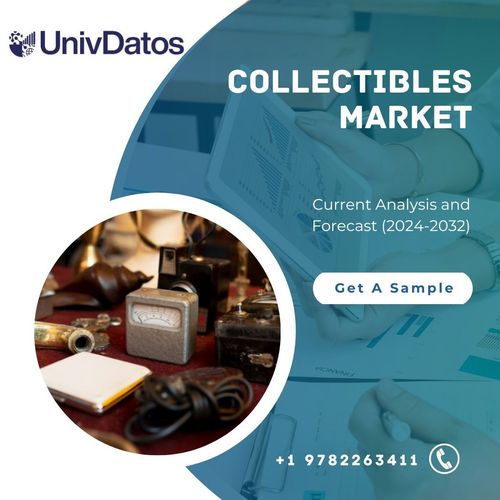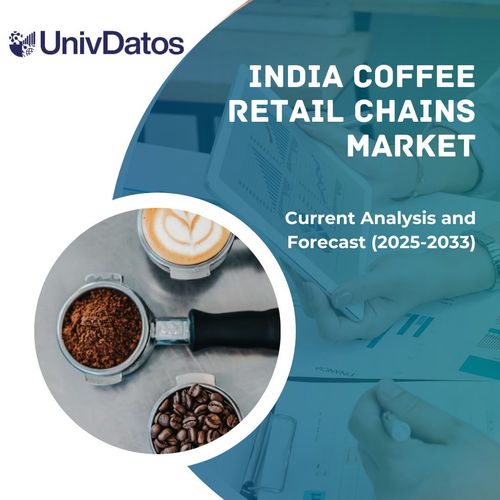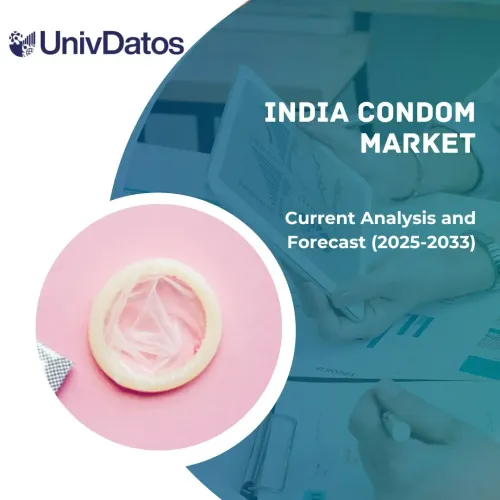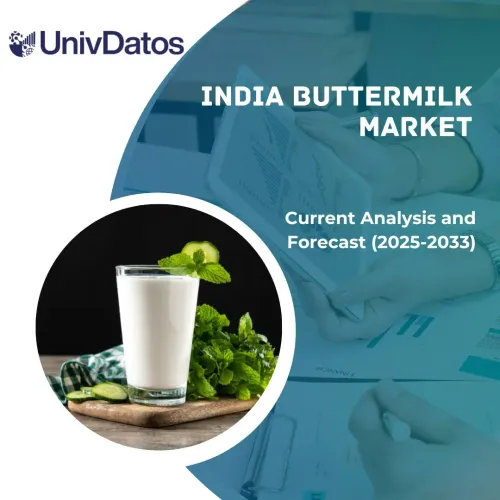- Home
- About Us
- Industry
- Services
- Reading
- Contact Us
Anti-Counterfeit Packaging Market: Current Analysis and Forecast (2024-2032)
Emphasis on Technology (Holograms, RFID, Mass Encoding, and Others), Packaging Format (Bottles & Jars, Vials & Ampoules, Pouches & Sachets, Tubes, and Others), End-user (Pharmaceuticals, Food and Beverage, Automotive, Personal Care, Electrical & Electronics and Others); and Region/Country
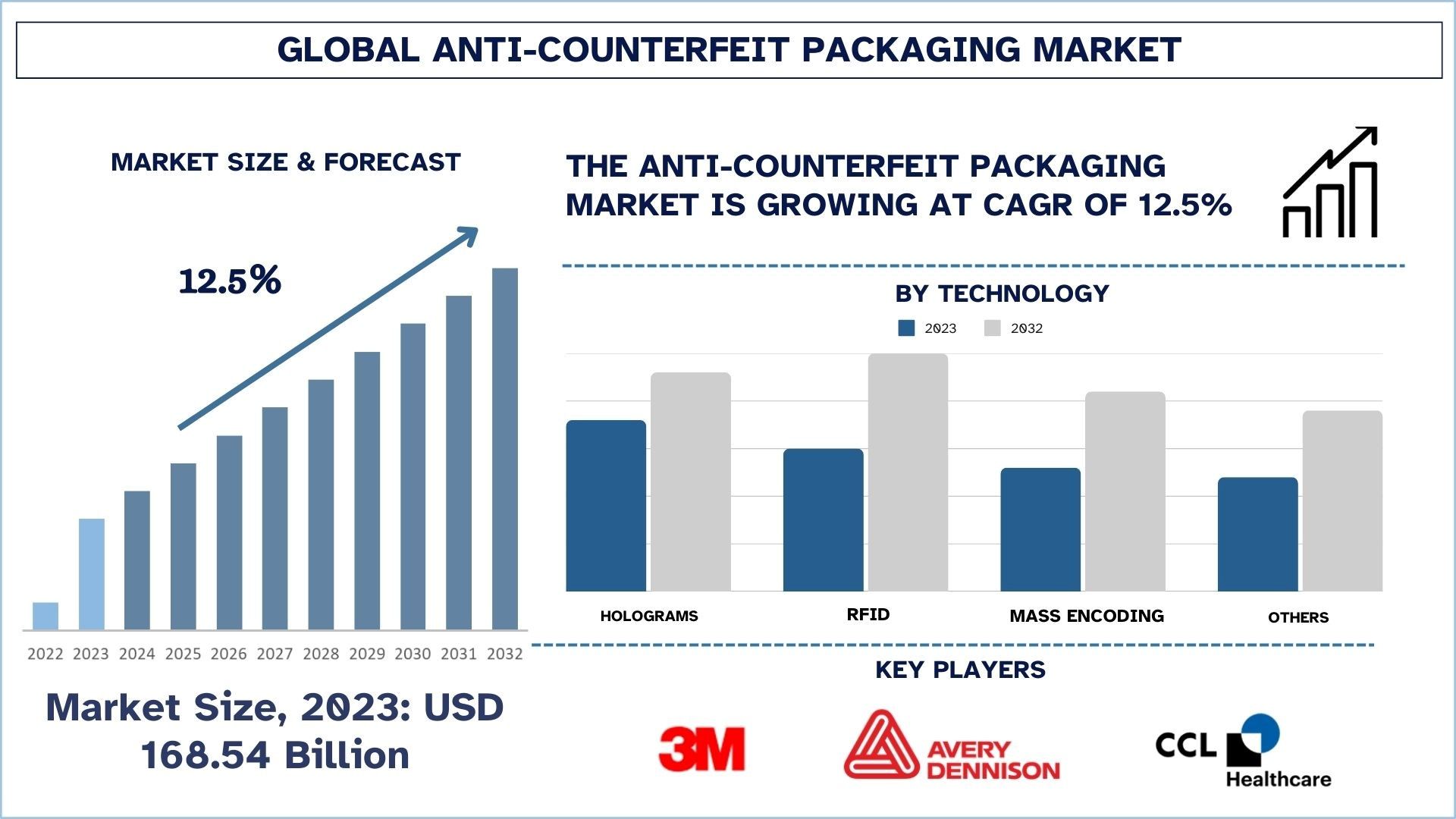
Anti-Counterfeit Packaging Market Size & Forecast
The Anti-Counterfeit Packaging Market was valued at approximately USD 168.54 billion in 2023 and is expected to grow at a substantial CAGR of around 12.5% during the forecast period (2024-2032) owing to the rising incidents of counterfeit goods, growing concerns about product safety and authenticity and rapid advancement of anti-counterfeit technologies, such as RFID, blockchain, smart packaging, and holograms.
Anti-Counterfeit Packaging Market Analysis
Anti-counterfeit packaging is a specialized packaging solution that protects products from duplicating and unauthorized handling and ensures product security and authenticity. Technology advances in anti-counterfeit packaging work through RFID tags, holograms, and tamper-evident seals with QR codes and forensic markers to protect both consumer safety and brand reputation along with safeguarding against counterfeits. Anti-counterfeit packaging techniques protect industries including pharmaceuticals, food and beverages, electronics, cosmetics, and luxury goods from counterfeit threats by keeping their authenticity intact while protecting consumer safety. The solutions serve the dual purpose of protecting brands from counterfeit attempts and meanwhile allowing for complete supply chain visibility required by regulatory bodies. The combination of e-commerce growth with globalization has resulted in heightened requirements for secure packaging because counterfeit products are now more common in online stores. Modern supply chains and product security strategies demand innovative anti-counterfeit packaging solutions since businesses need to combine brand protection with safety measures and regulatory compliance thus driving continuous market demand growth.
The anti-counterfeit packaging industry maintains strong momentum because counterfeit products continue to be prevalent in all sectors including pharmaceuticals, food and beverages, and luxury goods which endanger consumer protection and create a bad brand image. Government regulations like the Drug Supply Chain Security Act (DSCSA) along with EU directives force businesses to establish anti-counterfeit security measures. E-commerce's surge has amplified counterfeit product demand because online stores remain prone to counterfeit goods. Advanced technological solutions including RFID alongside blockchain and tamper-evident packaging enable real-time monitoring and authentic verification of products through their supply chain networks. Growing public understanding of product authenticity and brand protection serves as a main driver for market advancement.
Anti-Counterfeit Packaging Market Trends
This section discusses the key market trends influencing the various segments of the anti-counterfeit packaging market as identified by our research experts.
Growth of Smart Packaging
Smart packaging grows in anti-counterfeit markets because manufacturers seek advanced technologies for improving their product security during packaging. The addition of sensors along with RFID tags and QR codes in smart packaging systems enables real-time product surveillance and helps users detect tampering while tracking products throughout their life cycle. These solutions address counterfeiting by offering both precise details and simple access to product authenticity status along with supply chain tracking. Smart packaging systems empower customers to check product authenticity through digital verification capability delivered through mobile software and web interfaces. The market demand for transparency and safety drives industries to adopt smart packaging technologies which serve as essential countermeasures against counterfeiting and ensure product integrity in all sectors like food and beverages pharmaceuticals and luxury goods.
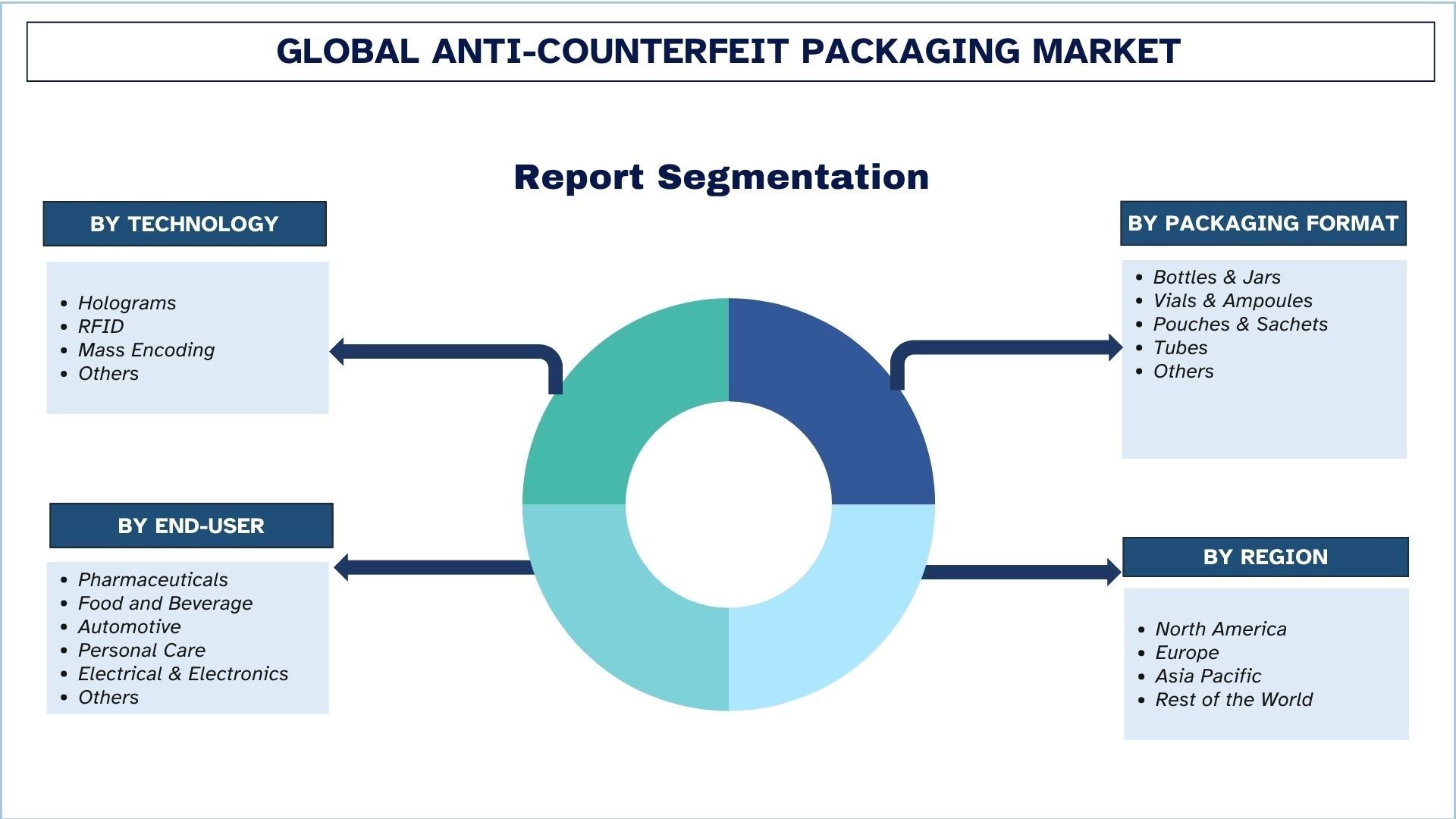
Asia-Pacific is expected to be the fastest-growing region
The Asia Pacific (APAC) region shows strong indications that it will experience the fastest market growth for anti-counterfeit packaging methods. Several factors accelerate the APAC region's growth such as industrialization momentum together with booming e-commerce and rising consumer preference for authentic products. China and India show rapidly growing counterfeit activity mainly in sectors such as pharmaceuticals, food and beverages, and electronics sectors. The implementation of strict counterfeit prevention measures by regional governments motivates businesses to use anti-counterfeit packaging solutions. The expansion of premium luxury product consumers across emerging markets drives authentic product demands simultaneously with the requirement for anti-counterfeit technology implementation. Some of the world’s biggest manufacturing facilities exist within this region which accelerates industrial demand for secure and tamper-proof packaging solutions across multiple industries.
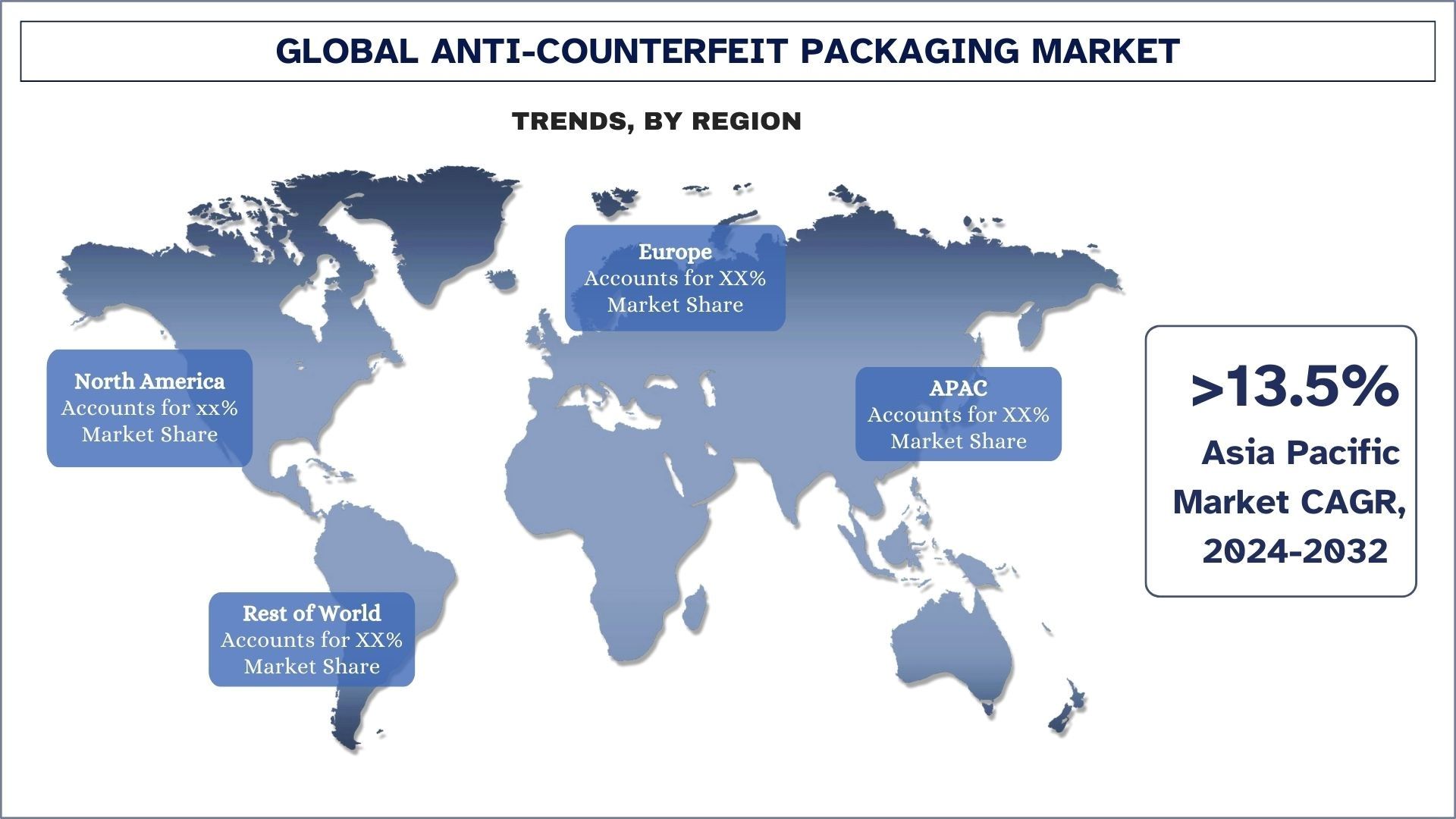
Anti-Counterfeit Packaging Industry Overview
The anti-counterfeit packaging market is competitive, with several global and international players. The key players are adopting different growth strategies to enhance their market presence, such as partnerships, agreements, collaborations, new product launches, geographical expansions, and mergers and acquisitions. Some of the major players operating in the market are 3M Company, Avery Dennison Corporation, CCL Industries Inc., DuPont, Zebra Technologies Corporation, SICPA Holding SA., SML Group, TruTag Technologies, Inc., Authentix, Inc., SATO Holdings Corporation.
Anti-Counterfeit Packaging Market News
In December 2022 – Holostik, a leader in anti-counterfeit packaging solutions launched a new packaging unit in Greater Noida with a new metallizer installed at the facility. The metallizer can be used for a variety of film types including those that are heat sensitive.
In September 2022 - UbiQD, Inc., a New Mexico-based nanotechnology company, and SICPA SA, a Swiss technology company and market leader in security inks, as well as a leading provider of secured authentication, identification, traceability, and supply chain solutions, announced the expansion of their partnership in the development of anti-counterfeit security inks based on UbiQD's quantum dot technology.
Anti-Counterfeit Packaging Market Report Coverage
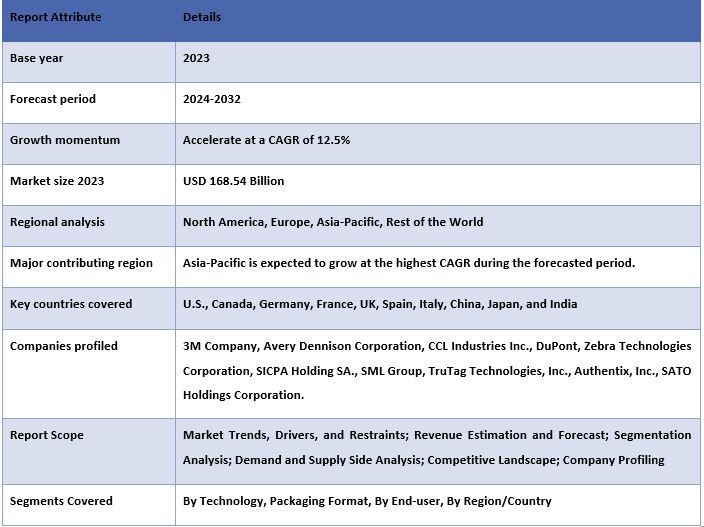
Reasons to buy this report:
The study includes market sizing and forecasting analysis validated by authenticated key industry experts.
The report presents a quick review of overall industry performance at one glance.
The report covers an in-depth analysis of prominent industry peers with a primary focus on key business financials, product portfolios, expansion strategies, and recent developments.
Detailed examination of drivers, restraints, key trends, and opportunities prevailing in the industry.
The study comprehensively covers the market across different segments.
Deep dive regional level analysis of the industry.
Customization Options:
The global anti-counterfeit packaging market can be customized further as per the requirement or any other market segment. Besides this, UMI understands that you may have your own business needs, hence feel free to connect with us to get a report that completely suits your requirements.
Table of Content
Research Methodology for the Anti-Counterfeit Packaging Market Analysis (2022-2032)
Analyzing the historical market, estimating the current market, and forecasting the future market of the global anti-counterfeit packaging market were the three major steps undertaken to create and analyze the adoption of Anti-counterfeit packaging in major regions globally. Exhaustive secondary research was conducted to collect the historical market figures and estimate the current market size. Secondly, to validate these insights, numerous findings and assumptions were taken into consideration. Moreover, exhaustive primary interviews were also conducted with industry experts across the value chain of the global anti-counterfeit packaging market. Post assumption and validation of market numbers through primary interviews, we employed a top-down/bottom-up approach to forecasting the complete market size. Thereafter, market breakdown and data triangulation methods were adopted to estimate and analyze the market size of segments and sub-segments of the industry. Detailed methodology is explained below:
Analysis of Historical Market Size
Step 1: In-Depth Study of Secondary Sources:
A detailed secondary study was conducted to obtain the historical market size of the anti-counterfeit packaging market through company internal sources such as annual reports & financial statements, performance presentations, press releases, etc., and external sources including journals, news & articles, government publications, competitor publications, sector reports, third-party database, and other credible publications.
Step 2: Market Segmentation:
After obtaining the historical market size of the anti-counterfeit packaging market, we conducted a detailed secondary analysis to gather historical market insights and share for different segments & sub-segments for major regions. Major segments are included in the report as technology, packaging format, end-user, and regions. Further country-level analyses were conducted to evaluate the overall adoption of anti-counterfeit packaging in that region.
Step 3: Factor Analysis:
After acquiring the historical market size of different segments and sub-segments, we conducted a detailed factor analysis to estimate the current market size of the anti-counterfeit packaging market. Further, we conducted factor analysis using dependent and independent variables such as technology, packaging format, end-user, and regions of the anti-counterfeit packaging market. A thorough analysis was conducted for demand and supply-side scenarios considering top partnerships, mergers and acquisitions, business expansion, and product launches in the anti-counterfeit packaging market across the globe.
Current Market Size Estimate & Forecast
Current Market Sizing: Based on actionable insights from the above 3 steps, we arrived at the current market size, key players in the global anti-counterfeit packaging market, and market shares of the segments. All the required percentage shares split, and market breakdowns were determined using the above-mentioned secondary approach and were verified through primary interviews.
Estimation & Forecasting: For market estimation and forecast, weights were assigned to different factors including drivers & trends, restraints, and opportunities available for the stakeholders. After analyzing these factors, relevant forecasting techniques i.e., the top-down/bottom-up approach were applied to arrive at the market forecast for 2032 for different segments and sub-segments across the major markets globally. The research methodology adopted to estimate the market size encompasses:
The industry’s market size, in terms of revenue (USD) and the adoption rate of the anti-counterfeit packaging market across the major markets domestically.
All percentage shares, splits, and breakdowns of market segments and sub-segments.
Key players in the global anti-counterfeit packaging market in terms of products offered. Also, the growth strategies adopted by these players to compete in the fast-growing market.
Market Size and Share Validation
Primary Research: In-depth interviews were conducted with the Key Opinion Leaders (KOLs) including Top Level Executives (CXO/VPs, Sales Head, Marketing Head, Operational Head, Regional Head, Country Head, etc.) across major regions. Primary research findings were then summarized, and statistical analysis was performed to prove the stated hypothesis. Inputs from primary research were consolidated with secondary findings, hence turning information into actionable insights.
Split of Primary Participants in Different Regions
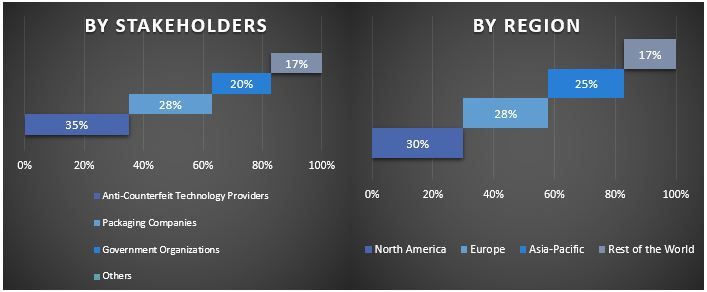
Market Engineering
The data triangulation technique was employed to complete the overall market estimation and to arrive at precise statistical numbers for each segment and sub-segment of the global Anti-counterfeit packaging market. Data was split into several segments and sub-segments after studying various parameters and trends in technology, packaging format, end-user, and regions of the global anti-counterfeit packaging market.
The main objective of the Global Anti-Counterfeit Packaging Market Study
The current & future market trends of the global anti-counterfeit packaging market were pinpointed in the study. Investors can gain strategic insights to base their discretion for investments on the qualitative and quantitative analysis performed in the study. Current and future market trends determined the overall attractiveness of the market at a regional level, providing a platform for the industrial participant to exploit the untapped market to benefit from a first-mover advantage. Other quantitative goals of the studies include:
Analyze the current and forecast market size of the anti-counterfeit packaging market in terms of value (USD). Also, analyze the current and forecast market size of different segments and sub-segments.
Segments in the study include areas of technology, packaging format, end-user, and regions.
Define and analyze the regulatory framework for the anti-counterfeit packaging
Analyze the value chain involved with the presence of various intermediaries, along with analyzing customer and competitor behaviors of the industry.
Analyze the current and forecast market size of the Anti-counterfeit packaging market for the major region.
Major countries of regions studied in the report include Asia Pacific, Europe, North America, and the Rest of the World
Company profiles of the anti-counterfeit packaging market and the growth strategies adopted by the market players to sustain the fast-growing market.
Deep dive regional level analysis of the industry.
Frequently Asked Questions FAQs
Q1: What is the anti-counterfeit packaging market's current size and growth potential?
The anti-counterfeit packaging market was valued at USD 168.54 billion in 2023 and is expected to grow at a CAGR of 12.5% during the forecast period (2024-2032).
Q2: What are the driving factors for the growth of the anti-counterfeit packaging market?
The anti-counterfeit packaging market is majorly driven by rising incidents of counterfeit goods, growing concerns about product safety and authenticity, and rapid advancement of anti-counterfeit technologies, such as RFID, blockchain, smart packaging, and holograms.
Q3: Which segment has the largest share of the anti-counterfeit packaging market by technology?
The RFID segment has the largest share of the anti-counterfeit packaging market by technology.
Q4: What are the major trends in the anti-counterfeit packaging market?
Increased use of blockchain technology, growth of smart packaging, and rise in forensic technologies are the major trends in the anti-counterfeit packaging market.
Q5: Which region will dominate the anti-counterfeit packaging market?
North America dominated the market in 2023.
Related Reports
Customers who bought this item also bought



